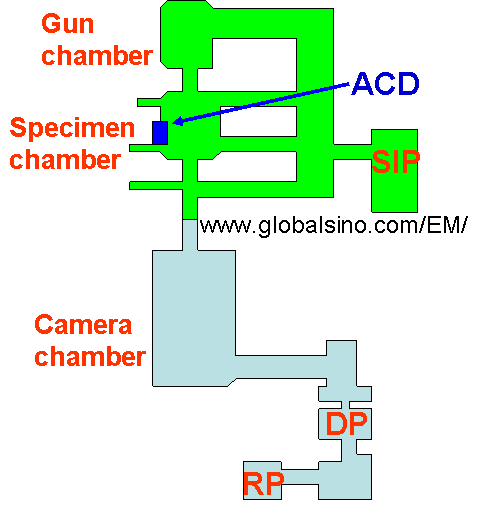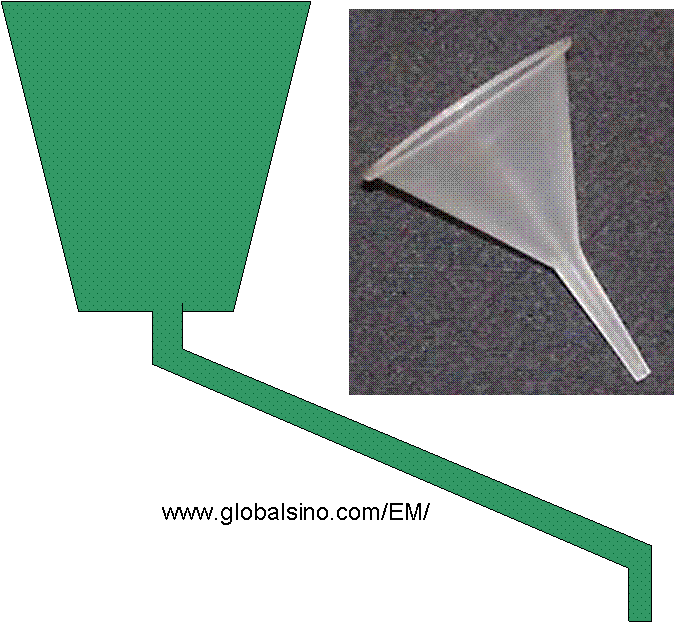=================================================================================
In most TEM (Transmission Electron Microscope) systems, an anti-contamination device (ACD) is placed in the specimen area so that the contamination level of the specimen is reduced. This ACD is cooled by an externally mounted dewar containing liquid nitrogen (LN2). In this case, the contaminants condense on the cooled surfaces near the specimen, rather than on the specimen. An anti-contamination fin installed in the specimen chamber in TEM is considered to be a kind of cryo-pump.
As an example, Figure 4209a shows schematic illustration of a TEM system. SIP, DP, and RP are sputter ion, diffusion, and rotary pumps, respectively.

Figure 4209a. Schematic illustration of a Transmission Electron Microscope (TEM) system.
ACD function: Used for heating the ACD at the end of the day. When the ACD button is depressed, the SIP turns off and the DP pumps on the column as the ACD warms up. When this process is complete, the SIP automatically turns back on.
The ACD operation procedures are slightly different from a TEM system to another, but are similar. The key steps are listed below.
Before TEM operation:
i) Check that the TEM system is not in ACD heat mode (ACD light off).
ii) More seriously: Check after 30 minutes to make sure the ACD HEAT button has switched off (e.g. the red light should go out).
iii) If the light is still on, press the button for 3 seconds to manually turn off the heater.
iv) Withdraw the ACD heater from cold trap. If the TEM system is in ACD heat mode, press and hold the ACD heat button for several seconds and then remove the ACD heater.
v) Place the TEM protective cover over the TEM view screen before dispensing liquid nitrogen, since spilt liquid nitrogen can crack the glass and potentially cause extensive and irreparable damage to the microscope.
vi) Insert a funnel into the refrigerant tank.
 |
Figure 4209. Two types of funnels for TEM. |
vii) Cold trap (refrigerant tank) filling/refilling: The dewar should be filled with liquid nitrogen before operation. After ~5 minutes (e.g. after the warmed gas blew up), fill it again.
viii) Put the cap on the refrigerant tank.
If you fail to fill with liquid nitrogen, the vacuum can gradually degrade as the ACD warms up. It is very important that the ACD does not run dry. Some TEM systems needs to be re-filled every 2 ~ 5 hours depending on the vacuum condition (air leakage) of the TEM system. The failure of filling liquid nitrogen will: (a) contaminate the TEM sample and (b) may cause ion pumps (IPs) and HT to turn off. Furthermore, if the vacuum of the TEM system is poor, it is better that you heat the cold trap (put the ACD on) in the next couple of hours, e.g. 3 ~ 5 hours, if nobody schedules to use the TEM system.
ACD heating at the end of the day (if nobody uses the TEM at night):
i) The specimen should be removed from the column before the ACD HEAT button is pressed.
ii) The liquid nitrogen in the ACD has to be burnt off. If this is not done, there is a danger of contamination of the column thereby effecting microscope performance.
iii) Insert the ACD heater into the cold trap (dewar). Watch out for the liquid nitrogen that will come pouring out of the tube.
iv) Insert the two contact pins of the heater in their plugs or connect its cable to the socket alongside (different microscope can have different configurations of electrical connections).
v) Depress the ACD heat button on the cold trap (Turn on the ACD heater on the computer if the TEM controls the ACD heat on and off with a PC). This will light up the indicator in red. This step will initiate a warm-up sequence which evaporates all contamination in the cold trap.
Fresnel fringes in TEM images depend on the TEM film thickness. Therefore, anticontaminator is often used to minimize carbon (C) contamination which increases the thickness of the film and thus makes the observation of the fringe more difficult.
|

